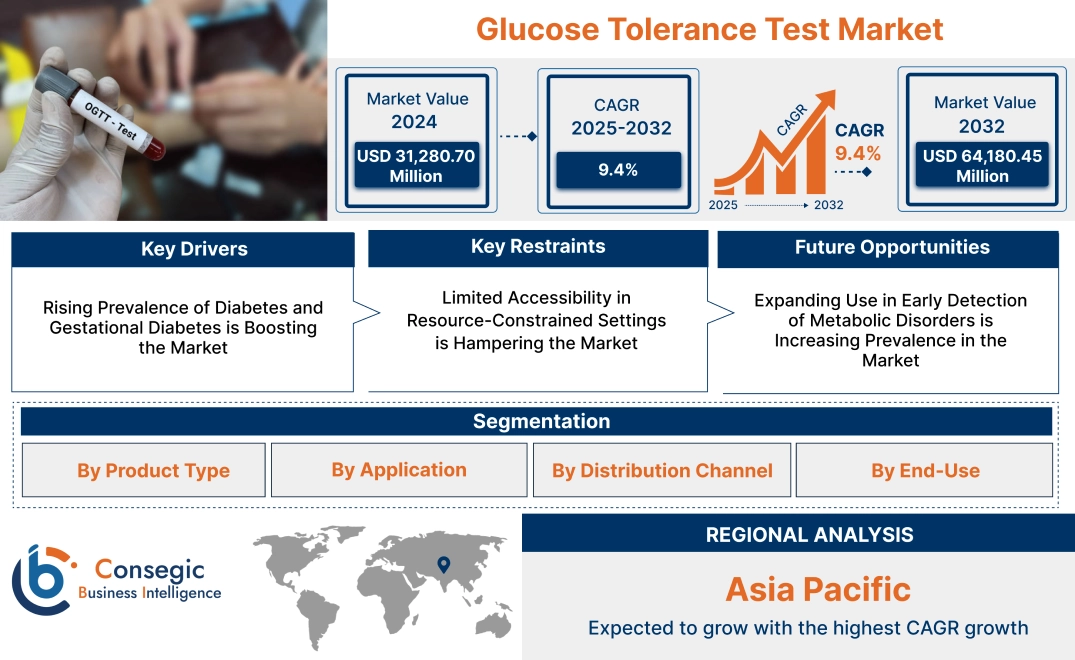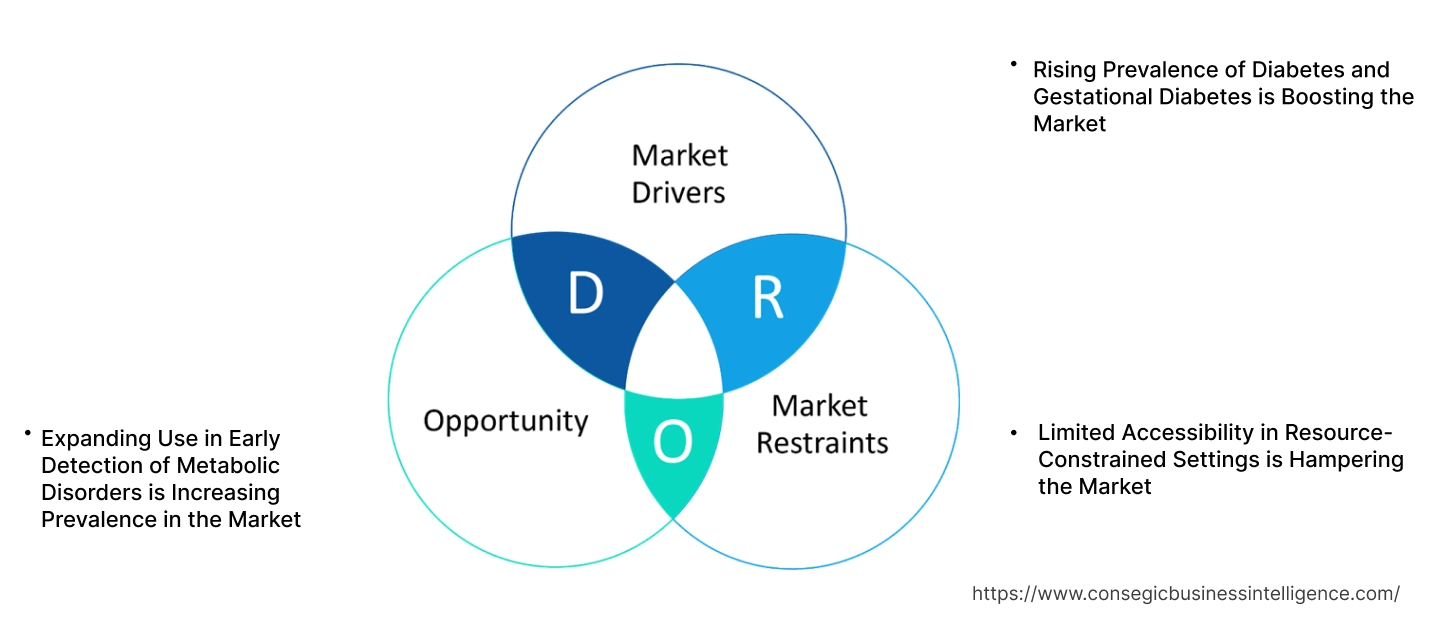- Summary
- Table Of Content
- Methodology
Glucose Tolerance Test Market Size:
Glucose Tolerance Test Market size is estimated to reach over USD 64,180.45 Million by 2032 from a value of USD 31,280.70 Million in 2024 and is projected to grow by USD 33,663.71 Million in 2025, growing at a CAGR of 9.4% from 2025 to 2032.
Glucose Tolerance Test Market Scope & Overview:
The glucose tolerance test (GTT) are diagnostic tool and procedure used to assess the body's ability to metabolize glucose, aiding in the detection of diabetes, prediabetes, and gestational diabetes. These tests involve monitoring blood glucose levels over time after consuming a glucose solution to evaluate insulin response and glucose metabolism. Key characteristics of GTT include high diagnostic accuracy, standardized testing protocols, and adaptability for various patient groups, including pregnant women. The benefits include early detection of glucose intolerance, effective diabetes management, and improved patient outcomes. Applications span clinical diagnostics, prenatal care, and routine health screenings. End-users include hospitals, diagnostic laboratories, and healthcare clinics, driven by the rising prevalence of diabetes, increasing awareness of early diagnosis, advancements in diagnostic technologies, and growing emphasis on preventive healthcare measures globally.
Key Drivers:
Rising Prevalence of Diabetes and Gestational Diabetes is Boosting the Market
The global increase in diabetes cases, including gestational diabetes, has significantly driven the demand for glucose tolerance tests (GTT). These tests play a crucial role in diagnosing impaired glucose tolerance, prediabetes, and gestational diabetes, which are essential for early intervention and effective management. With the aging population and growing rates of obesity, the prevalence of diabetes is expected to rise further, increasing the reliance on GTT as a standard diagnostic tool.
Trends in public health awareness campaigns and initiatives by healthcare organizations have emphasized the importance of regular screening for at-risk populations. Analysis highlights that glucose tolerance tests are becoming integral to preventive healthcare strategies, ensuring timely detection and reducing the long-term burden of diabetes-related complications.
Key Restraints:
Limited Accessibility in Resource-Constrained Settings is Hampering the Market
Despite the clinical importance of GTT, its accessibility remains limited in resource-constrained regions due to a lack of infrastructure, skilled healthcare personnel, and affordable diagnostic tools. Rural and underserved areas, where the prevalence of diabetes is rising, face significant challenges in implementing GTT at scale.
Trends in healthcare equity and outreach programs are attempting to bridge this gap, but the high costs and logistical complexities associated with GTT continue to pose barriers. The analysis underscores the need for cost-effective, portable, and easy-to-administer solutions to make these tests more widely available in low-resource settings.
Future Opportunities :
Expanding Use in Early Detection of Metabolic Disorders is Increasing Prevalence in the Market
The glucose tolerance test is increasingly recognized for its role in the early detection of metabolic disorders beyond diabetes, including metabolic syndrome and insulin resistance. As healthcare systems prioritize preventive approaches, GTT is being integrated into routine health screenings to identify at-risk individuals before the onset of severe conditions.
Trends in personalized medicine and lifestyle interventions further support the use of GTT as a diagnostic tool to guide tailored treatment plans. Analysis indicates that the rising emphasis on metabolic health and preventive care creates significant opportunities for the wider adoption of GTT, particularly as part of comprehensive health management programs.
Glucose Tolerance Test Market Segmental Analysis :
By Product Type:
Based on product type, the market is segmented into oral glucose tolerance test (OGTT) kits, intravenous glucose tolerance test (IVGTT) kits, standard glucose drinks, and glucose monitoring devices.
The oral glucose tolerance test (OGTT) kits segment accounted for the largest revenue in the glucose tolerance test market share in 2024.
- OGTT kits are widely used to diagnose diabetes and gestational diabetes due to their noninvasive nature and ease of administration.
- These kits are a preferred choice in hospitals, diagnostic laboratories, and specialty clinics for routine glucose tolerance testing.
- The increasing prevalence of type 2 diabetes and gestational diabetes globally has driven the demand for OGTT kits.
- Advancements in kit formulations, such as flavored glucose drinks for better patient compliance, have further supported segment glucose tolerance test market growth.
The glucose monitoring devices segment is anticipated to register the fastest CAGR during the forecast period.
- Glucose monitoring devices, including continuous glucose monitoring (CGM) systems, are increasingly adopted for real-time blood glucose tracking.
- These devices provide accurate and convenient results, making them ideal for both diagnostic and ongoing management purposes.
- Rising awareness about the importance of regular glucose monitoring in high-risk individuals is driving the adoption of this segment.
- Technological advancements, such as smartphone-integrated monitoring devices, are expected to propel glucose tolerance test market trends in the glucose monitoring devices market.
By Application:
Based on application, the market is segmented into diabetes diagnosis (type 1 diabetes, type 2 diabetes, gestational diabetes), insulin resistance testing, and reactive hypoglycemia detection.
The diabetes diagnosis segment accounted for the largest revenue share of 65.50% in 2024.
- GTT is a critical diagnostic tool for identifying type 1, type 2, and gestational diabetes, contributing to the dominance of this segment.
- The rising prevalence of diabetes globally, driven by lifestyle factors and aging populations, has increased the trends for diagnostic solutions.
- Gestational diabetes diagnosis through OGTTs is particularly common, given the increasing focus on maternal and fetal health.
- Regulatory guidelines recommending routine glucose tolerance tests for high-risk groups have further supported segment growth.
The insulin resistance testing segment is anticipated to register the fastest CAGR during the forecast period.
- Insulin resistance testing is gaining prominence as a preventive measure for managing prediabetes and metabolic syndrome.
- Rising awareness about the early detection of insulin resistance to prevent the progression to type 2 diabetes is driving trends.
- Advancements in testing methodologies and the growing adoption of personalized healthcare approaches are supporting this segment’s expansion.
- Increased emphasis on preventive care and wellness programs globally is expected to boost the adoption of insulin resistance testing.
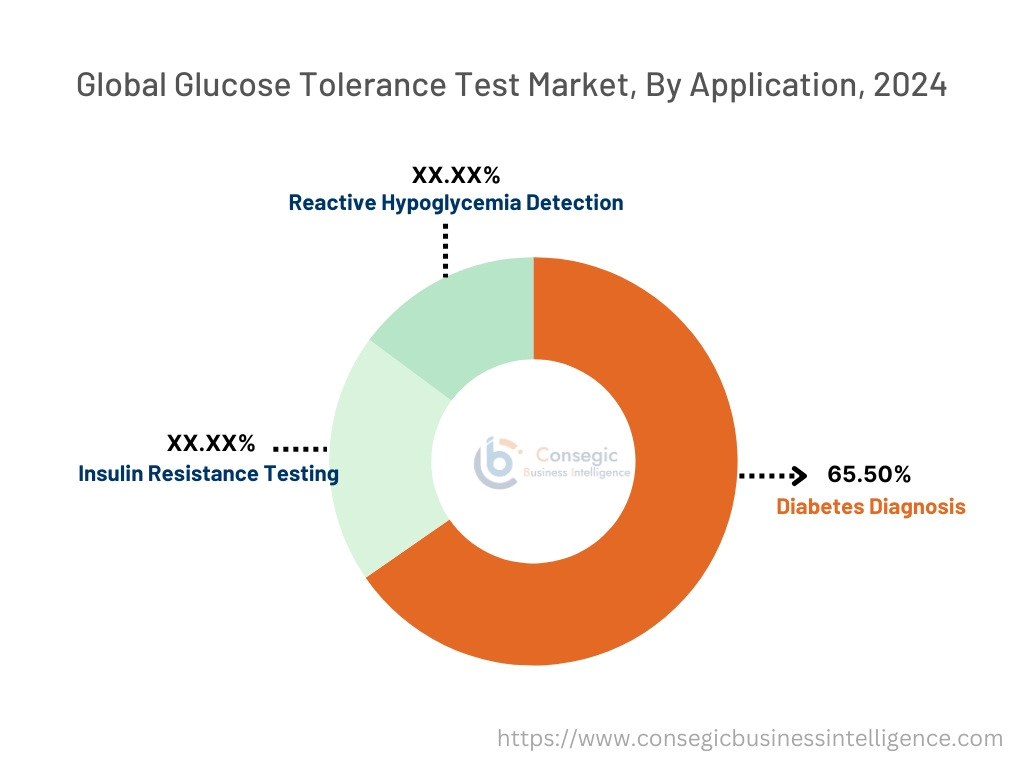
By Distribution Channel:
Based on distribution channels, the market is segmented into hospital pharmacies, retail pharmacies, and online pharmacies.
The hospital pharmacies segment accounted for the largest revenue in glucose tolerance test market share in 2024.
- Hospital pharmacies play a crucial role in dispensing GTT kits and standard glucose drinks for inpatient and outpatient use.
- The increasing number of hospital admissions for diabetes and related complications has driven trends for glucose tolerance testing products in this channel.
- Availability of specialized testing solutions and close monitoring by healthcare professionals contribute to the dominance of hospital pharmacies.
- Collaboration between hospitals and diagnostic kit manufacturers to streamline supply chains is further boosting growth in this segment.
The online pharmacies segment is anticipated to register the fastest CAGR during the forecast period.
- Online pharmacies are gaining traction due to their convenience, competitive pricing, and availability of a wide range of products.
- Rising adoption of e-commerce platforms for purchasing diagnostic kits and glucose monitoring devices is driving the glucose tolerance test market growth in this segment.
- Increased digital literacy and supportive regulations for online pharmacy operations are enhancing accessibility to GTT products.
- The COVID-19 pandemic accelerated the shift toward online pharmacy usage, a trend that continues to expand post-pandemic.
By End-Use:
Based on end-use, the market is segmented into hospitals, diagnostic laboratories, specialty clinics, and home care settings.
The diagnostic laboratories segment accounted for the largest revenue share in 2024.
- Diagnostic laboratories are the primary settings for conducting glucose tolerance tests due to their advanced infrastructure and skilled technicians.
- The increasing prevalence of diabetes and the growing emphasis on early diagnosis have driven glucose tolerance test market demand in laboratories.
- Rising investments in laboratory automation and advanced diagnostic equipment are supporting the dominance of this segment.
- Collaboration between laboratories and healthcare providers to deliver precise and timely results has further boosted trends.
The homecare settings segment is anticipated to register the fastest CAGR during the forecast period.
- The growing glucose tolerance test market trends toward patient-centric care and self-monitoring have increased the use of glucose monitoring devices and portable test kits in homecare settings.
- Rising awareness about proactive diabetes management among high-risk populations is driving growth in this segment.
- Technological advancements, such as smartphone-compatible monitoring devices, have enhanced the convenience of home-based glucose tolerance testing.
- Expanding telemedicine services and home delivery options for diagnostic kits are expected to further propel the glucose tolerance test market opportunities in this segment.
Regional Analysis:
The regions covered are North America, Europe, Asia Pacific, the Middle East and Africa, and Latin America.
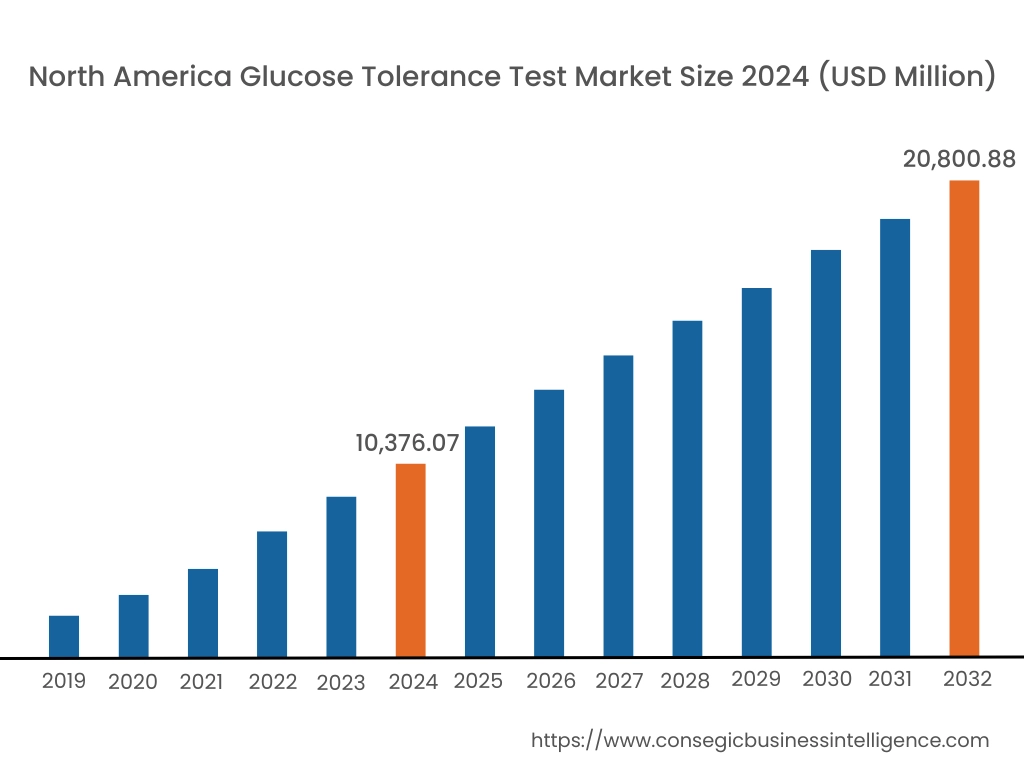
In 2024, North America was valued at USD 10,376.07 Million and is expected to reach USD 20,800.88 Million in 2032. In North America, the U.S. accounted for the highest share of 72.80% during the base year of 2024. North America holds a significant share in the glucose tolerance test (GTT) market, driven by the increasing prevalence of diabetes and gestational diabetes, advanced healthcare infrastructure, and widespread awareness of early disease detection. The U.S. leads the region due to a large diabetic population and the rising adoption of GTT in routine healthcare check-ups and prenatal care. As per the glucose tolerance test market analysis, Canada contributes with its growing focus on preventive healthcare and expanding diabetic screening programs. However, the high cost of diagnostic procedures may limit access to GTT services for some segments of the population.
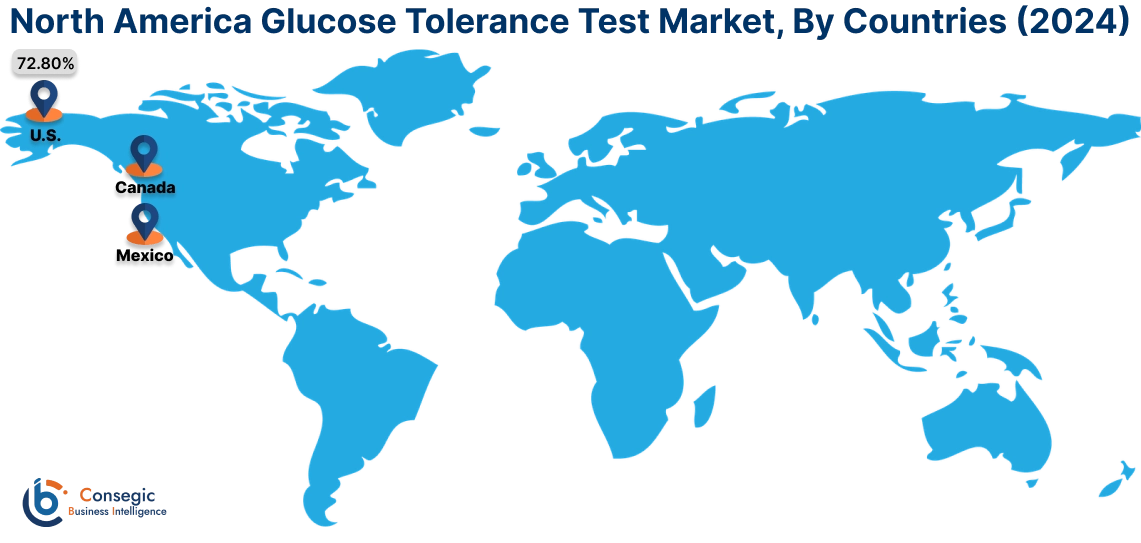
In Asia Pacific, the market is experiencing the fastest growth with a CAGR of 9.9% over the forecast period. The glucose tolerance test market analysis shows that it is fueled by a rapidly increasing diabetic population, urbanization, and growing awareness about early detection of metabolic disorders in China, India, and Japan. China dominates the region with rising adoption of glucose tolerance tests in both urban and rural healthcare settings, supported by government-led diabetes awareness campaigns. India’s growing healthcare infrastructure and increasing focus on maternal health drive demand for GTT, particularly in gestational diabetes screening. Japan emphasizes advanced diagnostic tools and regular health check-ups for its aging population. However, affordability and limited access to healthcare in rural areas may pose challenges in certain parts of the region.
Europe is a prominent market for GTT, supported by a growing elderly population, increasing prevalence of metabolic disorders, and strong government initiatives for diabetes screening and management. Countries like Germany, France, and the UK are key contributors. The analysis of Germany drives glucose tolerance test market demand with its robust healthcare system and focus on preventive diagnostics, particularly for gestational diabetes. France emphasizes the role of GTT in public health programs targeting early detection and management of diabetes. The UK is witnessing a growing adoption of GTT in prenatal care and routine health screenings. However, budget constraints in some public healthcare systems may affect the frequency of GTT implementation.
The Middle East & Africa region is witnessing steady growth in the glucose tolerance test market, driven by the increasing prevalence of diabetes and investments in healthcare infrastructure. Countries like Saudi Arabia and the UAE are adopting GTT as part of routine screening programs to address the high incidence of diabetes and gestational diabetes in their populations. In Africa, South Africa is emerging as a market, leveraging GTT for diabetes screening and maternal health programs. However, limited access to advanced diagnostic facilities and economic constraints in some parts of the region may restrict broader market development.
Latin America is an emerging market for glucose tolerance tests, with Brazil and Mexico leading the region. Brazil’s expanding healthcare sector and increasing prevalence of diabetes and obesity drive trends for GTT in both public and private healthcare facilities. Mexico focuses on incorporating GTT into prenatal care and routine health check-ups as part of its efforts to reduce diabetes-related complications. The region is also raising awareness about the importance of early diagnosis of gestational and type 2 diabetes. However, inconsistent healthcare infrastructure and economic instability in smaller economies may pose challenges to glucose tolerance test market expansion.
Top Key Players and Market Share Insights:
The glucose tolerance test market is highly competitive with major players providing products to the national and international markets. Key players are adopting several strategies in research and development (R&D), product innovation, and end-user launches to hold a strong position in the glucose tolerance test market. Key players in the glucose tolerance test industry include -
- Abbott Laboratories (United States)
- Hoffmann-La Roche AG (Switzerland)
- ARKRAY, Inc. (Japan)
- Nova Biomedical Corporation (United States)
- Medtronic plc (Ireland)
- Danaher Corporation (United States)
- Quest Diagnostics Incorporated (United States)
- Siemens Healthineers AG (Germany)
- Bio-Rad Laboratories, Inc. (United States)
- Thermo Fisher Scientific Inc. (United States)
Recent Industry Developments :
Product Launches:
- In August 2024, DirectSens, an Austrian biosensor developer, launched XpressGT®, a research-use-only (RUO) kit designed to detect insulin resistance-related conditions, including gestational diabetes, endometriosis, and liver disease. XpressGT measures 2-hydroxybutyrate (2-HB) levels in venous blood, providing results in just eight minutes. Elevated 2-HB levels are associated with insulin resistance and impaired glucose tolerance, making this kit a valuable tool for early detection and intervention. This development signifies a notable advancement in the glucose tolerance test market, offering a more efficient alternative to traditional methods like the oral glucose tolerance test (OGTT).
Glucose Tolerance Test Market Report Insights :
| Report Attributes | Report Details |
| Study Timeline | 2019-2032 |
| Market Size in 2032 | USD 64,180.45 Million |
| CAGR (2025-2032) | 9.4% |
| By Product Type |
|
| By Application |
|
| By Distribution Channel |
|
| By End-Use |
|
| By Region |
|
| Key Players |
|
| North America | U.S. Canada Mexico |
| Europe | U.K. Germany France Spain Italy Russia Benelux Rest of Europe |
| APAC | China South Korea Japan India Australia ASEAN Rest of Asia-Pacific |
| Middle East and Africa | GCC Turkey South Africa Rest of MEA |
| LATAM | Brazil Argentina Chile Rest of LATAM |
| Report Coverage |
|
Key Questions Answered in the Report
What is the projected market size of the Glucose Tolerance Test (GTT) Market by 2032? +
Glucose Tolerance Test Market size is estimated to reach over USD 64,180.45 Million by 2032 from a value of USD 31,280.70 Million in 2024 and is projected to grow by USD 33,663.71 Million in 2025, growing at a CAGR of 9.4% from 2025 to 2032.
What are the major drivers of the GTT market? +
Key drivers include the rising prevalence of diabetes globally, increasing awareness of early detection, advancements in diagnostic technologies, and growing emphasis on maternal and fetal health in gestational diabetes screening.
What challenges does the GTT market face? +
The primary challenges include limited accessibility to diagnostic tools in resource-constrained regions, high costs of testing procedures, and logistical complexities in implementing GTT at scale.
Which product type dominates the GTT market? +
The Oral Glucose Tolerance Test (OGTT) kits dominate the market due to their ease of administration, noninvasive nature, and widespread adoption in diabetes and gestational diabetes diagnosis.
